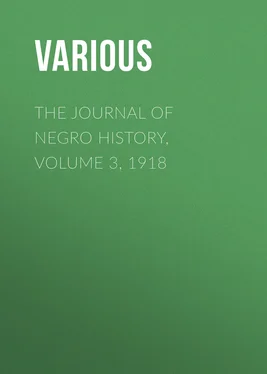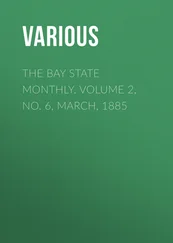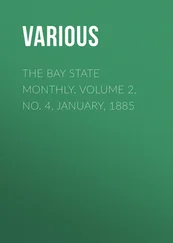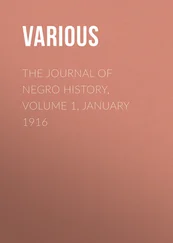Various - The Journal of Negro History, Volume 3, 1918
Здесь есть возможность читать онлайн «Various - The Journal of Negro History, Volume 3, 1918» — ознакомительный отрывок электронной книги совершенно бесплатно, а после прочтения отрывка купить полную версию. В некоторых случаях можно слушать аудио, скачать через торрент в формате fb2 и присутствует краткое содержание. Жанр: foreign_antique, periodic, История, foreign_edu, на английском языке. Описание произведения, (предисловие) а так же отзывы посетителей доступны на портале библиотеки ЛибКат.
- Название:The Journal of Negro History, Volume 3, 1918
- Автор:
- Жанр:
- Год:неизвестен
- ISBN:нет данных
- Рейтинг книги:5 / 5. Голосов: 1
-
Избранное:Добавить в избранное
- Отзывы:
-
Ваша оценка:
- 100
- 1
- 2
- 3
- 4
- 5
The Journal of Negro History, Volume 3, 1918: краткое содержание, описание и аннотация
Предлагаем к чтению аннотацию, описание, краткое содержание или предисловие (зависит от того, что написал сам автор книги «The Journal of Negro History, Volume 3, 1918»). Если вы не нашли необходимую информацию о книге — напишите в комментариях, мы постараемся отыскать её.
The Journal of Negro History, Volume 3, 1918 — читать онлайн ознакомительный отрывок
Ниже представлен текст книги, разбитый по страницам. Система сохранения места последней прочитанной страницы, позволяет с удобством читать онлайн бесплатно книгу «The Journal of Negro History, Volume 3, 1918», без необходимости каждый раз заново искать на чём Вы остановились. Поставьте закладку, и сможете в любой момент перейти на страницу, на которой закончили чтение.
Интервал:
Закладка:
A considerable portion of the book is concerned with the real life of the slave. Professor Ortiz believes that the punishments inflicted in Cuba were not so severe as in some other countries. He discusses the work done by the men, women and children, their habitations, food, dress and diversions. The diseases of the slave arising in adjusting themselves to the new world are also noted. Going further into the details of the life of the slaves, the author describes the urban Negroes and distinguishes this class of the bondmen from those of the plantation. He then discusses the free Negroes, who even from an early period constituted a considerable element of the black population and explains why some of them returned to Africa. The rights of all of the elements of the black population at law are mentioned so as to give the reader an idea of the black code as enforced in that island. How these classes thus kept down were moved from time to time to organize insurrections to secure their freedom, constitutes one of the chapters of the book.
On the whole it cannot be said that Professor Ortiz has shown that slavery in Cuba differed widely from what it was in some other large islands of the West Indies. He has, however, made a contribution to scholarship in showing exactly how this institution affected the life and the development of Cuba. The work is well illustrated and has an appendix of valuable documents bearing on slavery in Cuba.
C. G. Woodson.A Social History of the American Family, from Colonial Times to the Present. By Arthur W. Calhoun, PH.D. Volume I, Colonial Period. The Arthur H. Clark Company, Cleveland, U. S. A., 1917. Pp. 348.
This work is a study in genetic sociology to be completed in three volumes. The purpose of it is to develop an understanding of the forces that have been operative in the evolution of the family institution in the United States. The author will endeavor to set forth the influences that have shaped marriage, controlled fecundity, determined the respective status of father, mother, child, attracted relative and servant, influenced sexual morality and governed the function of the family as an educational, economic, moral, and spiritual institution as also its relation to state, industry, and society in general in the matter of social control.
In this first volume of the series the effort is to show that the American family is a product of European folkways, of the economic transition to modern capitalism, and of the distinctive environment of a virgin continent. How European customs brought to America underwent modification in the new environment and how differences of population in this country may be traced to geographical differences, constitute an important part of this treatise. The reader is finally directed to see the colonial family as a property institution dominated by middle class standards and operating as an agency of social control in the midst of the social order governed by the interests of a forceful aristocracy, which shaped religion, education, politics, and all else to its own profit.
On the whole this is a valuable work. When one has finished reading this volume, however, he must get the impression that the life of the slave attached to the colonial family has not been adequately treated. Among the early colonists the African slave was connected with the family after the manner of the bondmen of families in ancient countries. The slaves, being few in number, maintained this relation until the industrial revolution throughout the modern world changed the institution from a patriarchal to an economic one. Prior to this time the slaves were treated almost as well as the children of the family. They lived under the same roof, worshipped at the same altar and in some cases were taught in the same school. Care was taken so to elevate the slave and keep him above corrupting influences as to make him not merely a tool for exploitation but a decided asset in the family economy of life. That the slave of this type had much to do with the development of the colonial family no one will doubt.
In the chapter on servitude and sexuality in the South, the Negro slave gets negative mention. The author says that the presence of African slaves and Indians early gave rise to the problem of miscegenation. He concedes that it took some time to develop in the whites the attitude of race integrity and that the intercourse between men and women of the inferior race was never eliminated. During this period white women of the indentured servant class often yielded to miscegenation with the African male slaves and, as the author states, planters sometimes married white women servants to Negroes in order to transform the women and their offspring into slaves. The author might have added that this was especially true of Maryland.
The Readjuster Movement in Virginia. By Charles Chilton Pearson, Ph.D., Professor of Political Science in Wake Forest College. Yale University Press, New Haven, 1917. Pp. 191.
The author undertakes here to describe one of the developments in Virginia politics during the period between the Civil War and the first administration of Grover Cleveland. He considers the last fifty years of the history of Virginia the Dark Age during which there has been a period of radicalism followed by reaction. The Readjuster Movement was one of the independent waves of thought which characterized the reactionary period. It centered around William Mahone as the leader of an efficient machine endeavoring to readjust the State debt by compelling its creditors to share in the loss caused by the expensive internal improvement policy, the misfortunes of the Civil War and the extravagance of the Reconstruction period. It was in line with the general effort to readjust the economic and social policies of the entire country. It appealed to the people for the reason that unlike radicalism it was not obstructive of "democratic advance" in that it did not alienate the western section of the state through its attitude towards the Negro. Native in its origin, the democracy of the party was primarily intended for the whites, though the Negroes were accepted as desirable supporters. Such an independent movement was impossible until the continued defeat of the Republican party sufficiently removed the fears of the whites as to conduce to development of independent thinking. Citizens were thereafter more easily won to the cause of thus elevating the ruined and indebted classes by transferring to the government their will that the burdens of the State should be shifted to other shoulders. The author believes that this party found ready support also for the reason that it was not only a party but a social code and a state of mind which bound the whites to united and temperate action. He does not take the position that the work of the party was accomplished without conflict between the aristocratic and democratic forces. It required a long time to remove the differences between the aristocrats composed of the leaders of the old regime and the "soldier cult" on one hand and, on the other, the democratic element composed of the westerners and upstarts whom the Civil War and Reconstruction brought to power in the east, the poor whites and the freedmen.
It is interesting to note how he accounts for the fate of the Negro voter. He says that the Negro rising with the tide of democracy was about to be incorporated into the body politic, but that the habit of implicit obedience to overseers and a boss proved too strong. "These results," says he, "seemed to necessitate and to anticipate the elimination of the Negro as a voter." The decline of the political power of the Negro in Virginia is unfortunately considered by many as due to this cause. The author is wrong to leave the reader to infer that the Negro's incapacity to participate intelligently in the affairs of the government actually led to his elimination. The demands of race prejudice impelled all southern States to reduce the Negro to a lower status just as soon as the North loosed its hold on the South.
Читать дальшеИнтервал:
Закладка:
Похожие книги на «The Journal of Negro History, Volume 3, 1918»
Представляем Вашему вниманию похожие книги на «The Journal of Negro History, Volume 3, 1918» списком для выбора. Мы отобрали схожую по названию и смыслу литературу в надежде предоставить читателям больше вариантов отыскать новые, интересные, ещё непрочитанные произведения.
Обсуждение, отзывы о книге «The Journal of Negro History, Volume 3, 1918» и просто собственные мнения читателей. Оставьте ваши комментарии, напишите, что Вы думаете о произведении, его смысле или главных героях. Укажите что конкретно понравилось, а что нет, и почему Вы так считаете.












